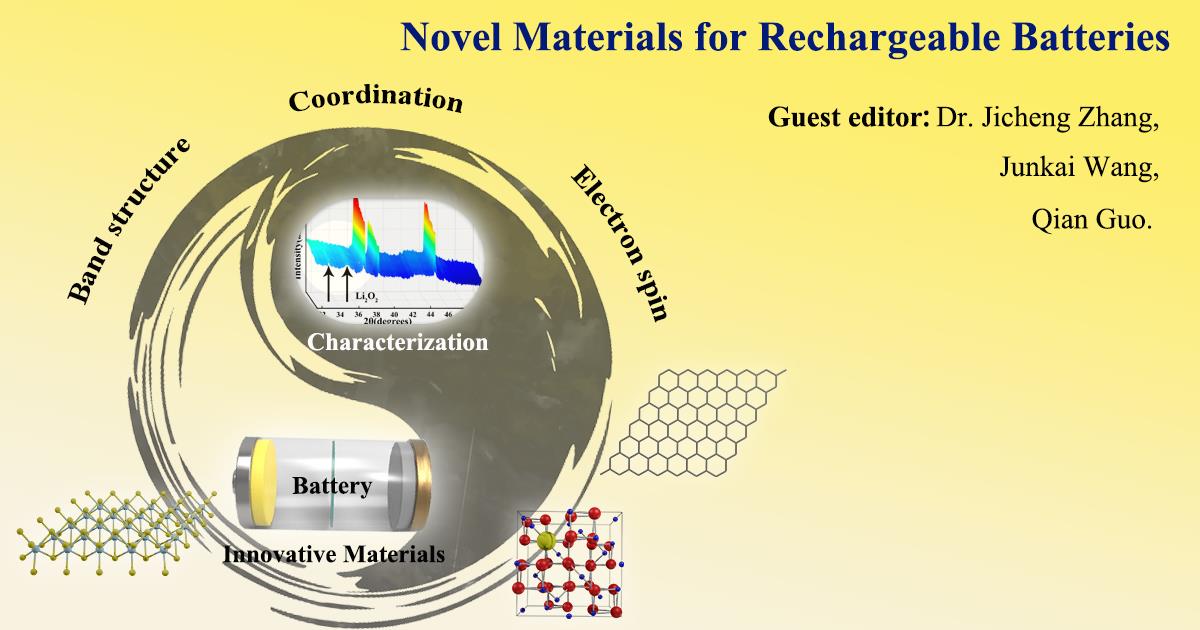Novel Materials for Rechargeable Batteries
A special issue of Batteries (ISSN 2313-0105). This special issue belongs to the section "Battery Materials and Interfaces: Anode, Cathode, Separators and Electrolytes or Others".
Deadline for manuscript submissions: closed (25 November 2025) | Viewed by 9056

Special Issue Editors
Interests: advanced energy storage and conversion materials; advanced chemical power devices
Interests: lithium–air battery; lithium–sulfur battery; electrocatalysts
Special Issues, Collections and Topics in MDPI journals
Special Issue Information
Dear Colleagues,
Sustainable solutions to producing and storing energy are in high demand to ensure our world’s sustainable development. Therefore, energy storage and conversion have been witnessing a surge in interest in recent years. So far, significant progress has been made in high-performance batteries. New materials and mechanisms have paved a solid foundation for improvements.
This Special Issue focuses on the intrinsic structural characteristics of the novel materials that determine battery performance. Specifically, the band structure, coordination environment, electron spin, and lattice stress of active materials play key roles in redox or catalytic reactions. Simultaneously, advanced characterization techniques are essential in revealing the complicated chemical processes in these new mechanisms. This Special Issue will provide insights into new materials and mechanisms that are driving the development of advanced batteries.
In this Special Issue, original research articles and reviews are welcome. Research areas may include (but are not limited to) the following:
- Alkali-ion batteries;
- Zn-ion batteries;
- Al-ion batteries;
- Mg-ion batteries;
- Metal–air batteries;
- Li–S batteries;
- Solid-state batteries;
- Aqueous batteries;
- Redox flow batteries.
We look forward to receiving your contributions.
Dr. Jicheng ZhangDr. Junkai Wang
Dr. Qian Guo
Guest Editors
Manuscript Submission Information
Manuscripts should be submitted online at www.mdpi.com by registering and logging in to this website. Once you are registered, click here to go to the submission form. Manuscripts can be submitted until the deadline. All submissions that pass pre-check are peer-reviewed. Accepted papers will be published continuously in the journal (as soon as accepted) and will be listed together on the special issue website. Research articles, review articles as well as short communications are invited. For planned papers, a title and short abstract (about 250 words) can be sent to the Editorial Office for assessment.
Submitted manuscripts should not have been published previously, nor be under consideration for publication elsewhere (except conference proceedings papers). All manuscripts are thoroughly refereed through a single-blind peer-review process. A guide for authors and other relevant information for submission of manuscripts is available on the Instructions for Authors page. Batteries is an international peer-reviewed open access monthly journal published by MDPI.
Please visit the Instructions for Authors page before submitting a manuscript. The Article Processing Charge (APC) for publication in this open access journal is 2700 CHF (Swiss Francs). Submitted papers should be well formatted and use good English. Authors may use MDPI's English editing service prior to publication or during author revisions.
Keywords
- intrinsic structural characteristics
- redox
- cathode and anode
- batteries
- catalytic reactions
- mechanisms
- advanced characterization techniques
- novel materials
Benefits of Publishing in a Special Issue
- Ease of navigation: Grouping papers by topic helps scholars navigate broad scope journals more efficiently.
- Greater discoverability: Special Issues support the reach and impact of scientific research. Articles in Special Issues are more discoverable and cited more frequently.
- Expansion of research network: Special Issues facilitate connections among authors, fostering scientific collaborations.
- External promotion: Articles in Special Issues are often promoted through the journal's social media, increasing their visibility.
- Reprint: MDPI Books provides the opportunity to republish successful Special Issues in book format, both online and in print.
Further information on MDPI's Special Issue policies can be found here.







